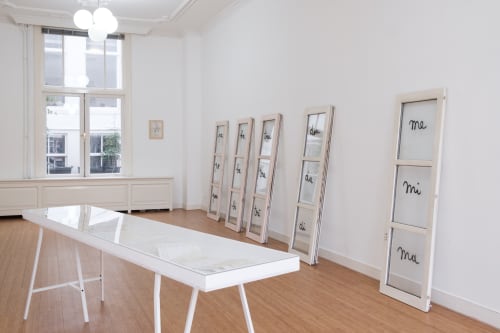Curation and words by Sergi Rusca
This exhibition is articulated as an ontological opening,[1] that is, a proposal where artistic practices enact a multiplicity of aesthetic and conceptual overlaps around language. The displayed artworks allow for a conversation on representation, speculation, and wording, while insinuating both its material limits and its open-ended semantic qualities. Considering the exhibition as a device capable of producing objects and subjects by placing them in an emergence of meanings and correlations,[2] the artists involved explore liminal thresholds of language as the central medium of creative articulation.
Transposing from anthropologist Marisol de la Cadena’s explanation on the concept of not only – in the context of translation practices in Western-based historical readings of Andean Indigenous spiritualities – it indicates plurality in meaning, so what can be defined as one thing (for example, a painting) is not only that, as it is subject to more meanings insomuch as both its definition and its form are never settled, and it is likely that we would not know what it (a painting) not only is. “Not only indicates a potential emergence that could challenge what we know, the ways we know it, and even suggest the impossibility of our knowing, without such impossibility cancelling the emergence”, De la Cadena argues.[3] Not only, thus, works as a tool for ontological exploration, as it allows for singularity to become ambiguous. Used in this exhibition, it sets the artistic object as a most powerful means for speculation, in an ongoing process of signification in art in and out of itself.
Daniele Formica’s practice could be described as cartographic, as he superimposes layer upon layer of cognitive, emotional, and ontological entanglements onto vulnerable mapping exercises that ultimately form a complex artistic atlas. In his work, oftentimes drawing from classical literature, language enunciates thought while tracing coordinates in his entropic mind. Words, as if entries on a diary, emerge from his vital experience and create linguistic rhythms of repetition and alternation wherein to gather and position fragmented identities and knowledges.
Anne-Lise Coste is constantly engaging in dialogue with found objects. Working directly onto them with airbrush, she sets up an immediate resignification that does not seek to elevate the apparent banality of the object, but rather to express semiotic ambiguity. Drawing from the surrealist and dada movements, Coste plays with the mismatch between the object and the painted word. A syllabic system is sprayed on the glass panels of the windows. Reminiscent of how spoken and written language is taught at schools, the concatenation of words generates a poem made up of sounds. A leitmotiv in her practice, the artist performs a lyrical deconstruction of the objects as an embodied principle against dogmatism and arbitrariness.
In the pursuit of dissolving himself in the creative process, Klaas Kloosterboer approaches painting as a modus operandi to both question and inform artistic practice. Disinterested in representation as an ultimate and absolute goal, he allows his work to be about the processual nature of living and creating. A single word on a canvas becomes a vessel for a plurality of interpretations; painting ensues, an exploration through the plasticity of brushstrokes. In his work, it could be argued that language stands as a catalyst for coincidence and disagreement, mobilising a malleable dictionary of our definitions for the world.
Following her interest in James Joyce as a social and literary phenomenon and her film The Joycean Society (2013), Dora García embarked on a research on the Irish author and his ties to Norway and in particular the writer Henrik Ibsen. During his youth, Joyce studied Norwegian to be able to read Ibsen in its original language, and in 1901, on Ibsen’s seventy-first birthday, he wrote a letter of admiration to him. The original letter, however, is lost, and only the draft remains. In 12 Attempts to Forge a Letter from Joyce to Ibsen in 1901 (2014), García handwrites the lost communication between the two authors; a speculative exercise that explores the blurred boundaries between the real and its linguistic representation whilst conceiving the acts of writing and reading as an unending interchange between reader and text, both affecting and depending on one another.[4]
[1] This term is proposed by Marisol de la Cadena in relation to her ethnographic practice and her approach in how knowledge is understood and practiced. See Marisol de la Cadena, “Earth-Beings. Andean Indigenous Religion, but Not Only”, in Keiichi Omura et altri (eds), The Word Multiple. The Quotidian Politics of Knowing and Generating Entangled Worlds (Routledge, 2018), pp. 45-66.
[2] This consideration draws from Anselm Franke’s essay “The Third House” in the journal Site 0. Castalia: the Game of Ends and Means (2016): https://www.glass-bead.org/article/the-third-house/?lang=enview
[3] Marisol de la Cadena, “Earth-Beings. Andean Indigenous Religion, but Not Only”, in André Jaque et altri (eds.), More-than-Human, (Het Nieuwe Instiuut, 2020), p. 393
[4] This conception draws from Derek Attridge’s study on the work of James Joyce. See Derek Attridge, The Cambridge Companion to James Joyce, Cambridge University Press, 2004).





